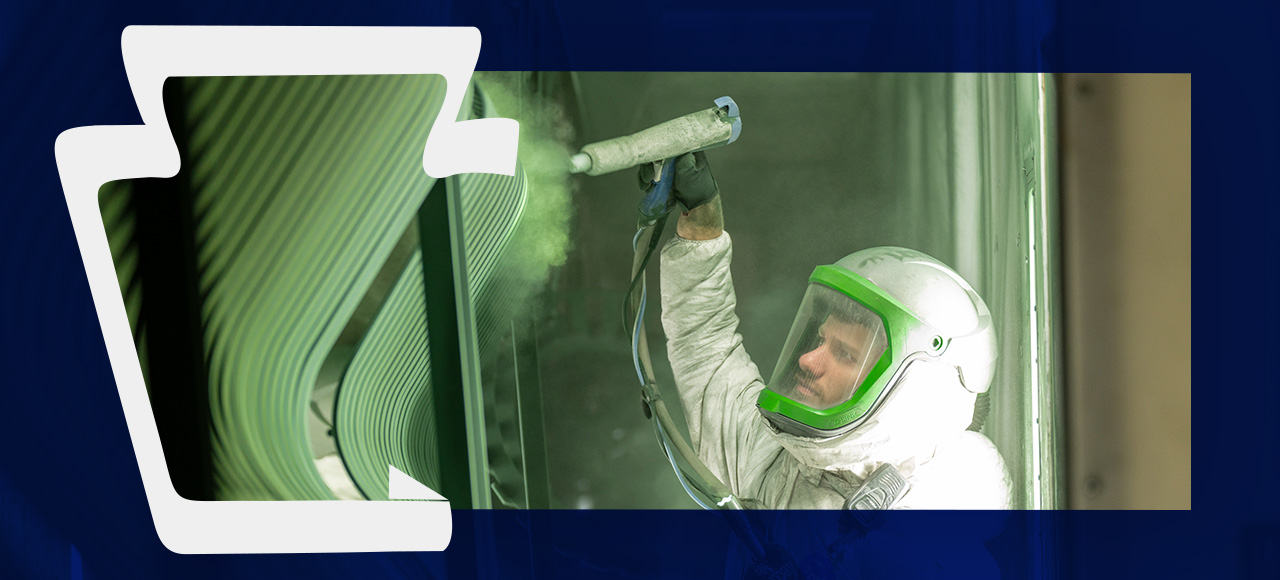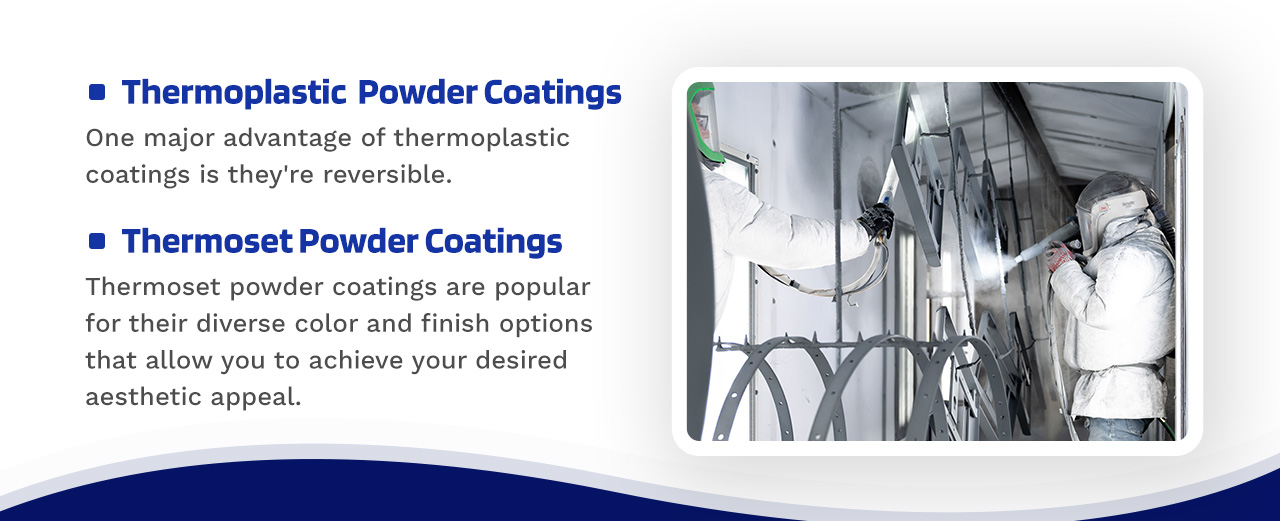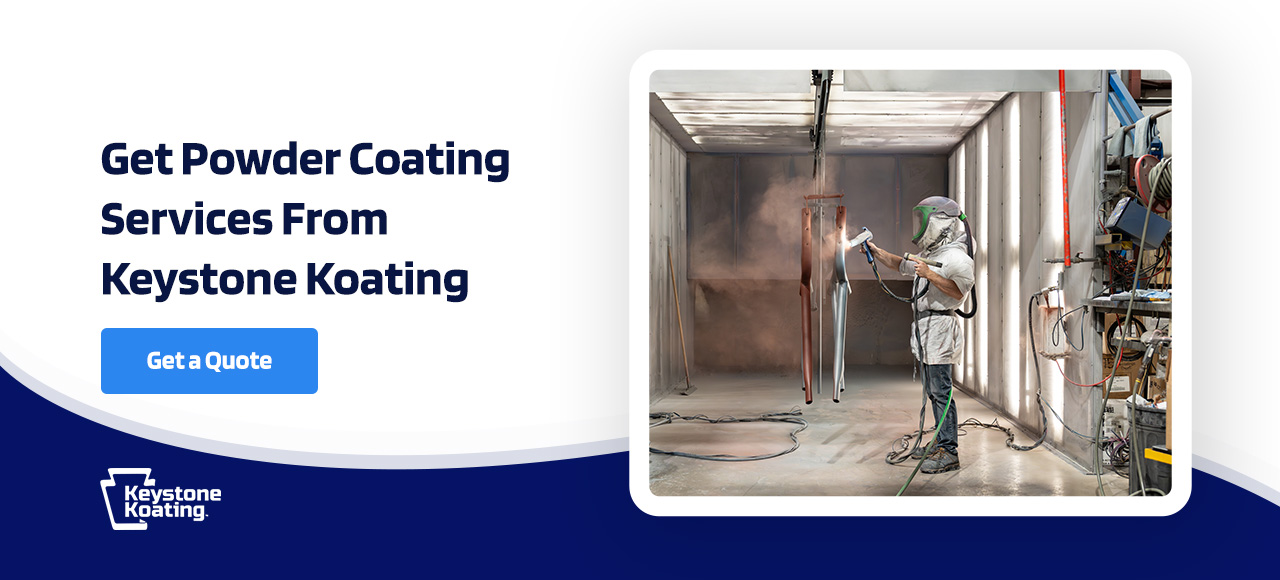
Powder coating is a durable and eco-friendly process of finishing metal products that’s suitable for a variety of applications. It’s an effective alternative to liquid paint that comes in many colors and textures and provides long-lasting aesthetic appeal.
Thermoplastic and thermoset powder coatings are common types used in the manufacturing industry. Though they sound similar, they have different chemical properties, making each better suited for certain applications. In this guide, we’ll discuss thermoplastic and thermoset powder coatings to help you distinguish between the two and identify the one that works best for your specific application.
What Are Thermoplastic Powder Coatings?
Thermoplastic powder coatings are thick, high-quality, corrosion-resistant and impact-resistant. They are often used to create a protective layer on metal or plastic parts of household appliances, such as refrigerators, ovens, pieces of furniture, gym equipment and lighting fixtures. Examples of thermoplastic powder coatings include nylon, polyvinyl chloride (PVC), Teflon and polyester.
Fluidized Bed Dipping vs. Electrostatic Spray Application
Thermoplastics soften when heated and become more fluid as they’re heated further. Most often, thermoplastic powder coatings are applied via fluidized bed dipping. To start, a powder coating expert places a bed of thermoplastic powder at the bottom of a box. Below the box is a porous membrane and, below that, a plenum chamber. The chamber is pressurized, causing air to flow through the entire contraption. The flowing air causes the powder to rise and become fluid-like. From there:
- A clean metal part is preheated to a temperature above the melting point of the thermoplastic powder.
- The powder coating expert dips the metal part into the bed of fluidized powder coating, moving it around to ensure evenness.
- The part remains submerged in the bed until the coating reaches the desired thickness.
- The expert allows the excess powder to drip off the part before moving it to a lower-temperature oven for curing. During this step, the powder melts onto a smooth coating.
Another newer application is the electrostatic spray application. With this method, the powder coating is electrically charged so that it becomes attracted to the metal surface. Once the part is coated, it’s heated in the oven, where the thermoplastics melt and become smooth.
Pros and Cons of Thermoplastic Powder Coatings

One major advantage of thermoplastic coatings is they’re reversible. Thermoplastics do not form chemical bonds as they melt, cool and remelt, so if there’s a mistake or if a part gets damaged, powder coating experts can simply reheat the coating. It’ll melt, allowing the part to be repaired. This also makes thermoplastic powder coatings sustainable and environmentally friendly — they can be reshaped and remolded into different materials.
Additionally, thermoplastic powder coatings are:
- Strong and durable.
- Resistant to impact.
- Resistant to wear and tear.
- Soft to the touch.
- Made without emitting volatile organic compounds (VOCs).
- Waterproof.
- Excellent electrical insulators.
However, thermoplastic powder coatings are not ideal for products that are exposed to high amounts of heat. They also may be more expensive than other powder coating methods. Additionally, with thermoplastic powder coatings, you have a limited number of colors and finish options.
What Are Thermoset Powder Coatings?
Thermoset powder is also heated and cured to produce a thick and durable coating on various metal surfaces. Thermoset powders can be derived from the following groups:
- Acrylics
- Epoxies
- Hydroxyls (polyester)
- Carboxyl (polyurethane)
Most often, thermoset powder is epoxy- or polyester-based.
The thermoset powder coating process is similar to the thermoplastic powder coating process — both the fluidized bed dipping method and the electrostatic spray application are effective options. However, thermoset plastics contain polymers that “cross-link” during the curing process. As a result, irreversible chemical bonds are created, meaning the coat cannot be remolded.
Pros and Cons of Thermoset Powder Coatings
Thermoset powder coatings are popular for their diverse color and finish options that allow you to achieve your desired aesthetic appeal. And unlike thermoplastic powder coatings, they won’t melt when exposed to high heat. They’re suitable for metal items that need to withstand high amounts of heat and heavy wear and tear, like electronics, appliances, coils, screens and wires. They’re also ideal for aerospace, automotive and medical parts that are often exposed to UV rays and chemicals.
With thermoset powder coatings, you can also count on the following advantages:
- High tensile strength
- Lots of color and finish options
- Cost-effectiveness
- Dimensional stability
- Flexible design
- Corrosion-resistance
However, the irreversible nature of thermoset powder coatings makes them less sustainable and environmentally friendly than thermoplastic coatings. Faulty parts finished with thermoset powders must be dumped because they can’t be reshaped, remolded or recycled. Still, it’s important to mention that, like thermoplastic powder coatings, thermoset powder coatings do not contain solvents or produce VOC emissions.
What Is the Difference Between Thermoplastic and Thermoset Powder Coatings?
The main distinction between thermoplastic and thermoset powder coatings is how they respond to heat during the curing process. The following table highlights the top differences between the two main powder coatings.
| THERMOPLASTIC POWDER COATINGS | THERMOSET POWDER COATINGS |
|---|---|
| Do not form chemical bonds to the metal part | Form chemical bonds to the metal part |
| More expensive | Affordable and cost-effective |
| Able to be remelted, reshaped and recycled | Irreversible and cannot be remelted, reshaped or recycled |
| Functional coatings with limited color and finish options | Decorative and aesthetic coatings with numerous colors and finish options |
| Recyclable, BPA-free, halogen-free, solvent-free and VOC-free | Solvent-free and VOC-free |
Thermoplastic vs. Thermoset Powder Coatings: Which Is Better?
Thermoplastic and thermoset powder coatings offer many benefits — the one you choose depends entirely on your application. If you need a powder coating that can withstand high temperatures and is more cost-effective, thermoset powder coatings may be the ideal solution. If you want a sustainable method that provides good electrical insulation, you may choose a thermoplastic powder coating. It all depends on your needs!
Get Powder Coating Services From Keystone Koating
Keystone Koating provides high-quality powder coating services for commercial and industrial projects. We’ve been in the business since 1986, so our processes are time-tested and backed with extensive expertise to ensure high-quality powder coating finishes. Our expert team can help you choose the best powder coating type for your unique needs.
We also provide our customers with an eight-step pretreatment process to ensure an even coating that stands the test of time. Our two assembly lines in Pennsylvania help us guarantee fast turnaround times. Contact us today to learn more about our powder coating services, or request a free quote for your project.


